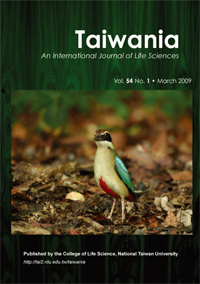Research Paper
A Rule-Based Species Predictive Model for the Vulnerable Fairy Pitta (Pitta nympha) in Taiwan
Chia-Ying Ko, Pei-Fen Lee, Mei-Ling Bai, Ruey-Shing Lin
Published on: March 2009
Page: 28 - 36
DOI: 10.6165/tai.2009.54(1).28
Abstract
A fundamental step in biodiversity conservation is to identify potential distribution and quality habitat for a desired species, especially when the target is rare and difficult to detect. We demonstrated a GIS application in developing a quick predictive model to study the globally vulnerable Fairy Pitta (Pitta nympha) in Taiwan. We compiled sighting data between 1982 and 2000, established a rule-based model to predict its distribution, and applied the predictive map to design a sampling protocol, conduced field surveys to evaluate the accuracy of the model and to obtain hotspots. The results showed that most known distribution of the Fairy Pitta occurred in low elevation, hilly and forested areas. The map predicted 21.6% areas of Taiwan suitable for the Fairy Pitta and 78% of them occurred in western Taiwan. A total of 511 pittas were detected during the 2001 survey that covered 4% areas of Taiwan or 14.3% of predictive areas, with a mean of 30.2% detection probability per grid cell (2 × 2 km in resolution). The adjusted data indicated that the overall accuracy of our model was increased to 40.3% with 290 qualified cells. Most of the new sightings of the Fairy Pitta arising from the 2001 field survey fell in our predictive areas with most of them occurring in western Taiwan. The probability of detecting pitta was highest in the active selection cells within predictive areas. Based on mean number of pitta detected per cell, the hotspots of the Fairy Pitta in Taiwan included three regions: the watershed of Shimen Reservoir within Hsinchu and Taoyuan County, Linnei of Yulin County and the watershed of Wusanto Reservoir in Tainan County. We concluded that the model provides quick and effective predictions for planning conservation strategies and is particularly useful for rare species.
中文摘要
確認稀有性物種的分布和其適宜性棲地是生物多樣性保育的基本工作。本研究展現利用地理資訊系統,針對臺灣的全球易危性物種—八色鳥 (Pitta nympha) ,發展一個簡易又快速的分布預測模式。收集1982 至2000 年的觀察記錄,建立八色鳥的規則化分布預測模式,並利用預測圖設計野外調查,以標準化的方法評估此模式的效能,建立熱點位置。結果顯示,八色鳥分布於低海拔且有森林覆蓋的丘陵地區。預測圖估計台灣約有21.6%的區域,可能會有八色鳥的出現,其中約有78%處在西部。在2001 年的調查(調查區域約佔全台4%,或預測區的14.3%)中,共發現511 隻八色鳥,平均每一個2 × 2公里網格的發現機率為30.2%,以比較嚴格篩選的網格資料(共290 格),模式準確度則為40.3%。新發現有八色鳥出現的網格分布,大致與預測模式的型態相似,且93.9%出現在臺灣西部。每網格內的發現機率,以在預測區域內的刻意選擇區最高。以網格的出現機率為標準,八色鳥熱點出現在新竹與桃園縣石門水庫附近、雲林縣的林內鄉、臺南縣烏山頭水庫附近的山區。本模式特別適合稀有性物種,方法簡易又有效,可以協助瞭解物種的可能分布範圍,進而提供更適宜的保育策略。
Keyword: Niche, rule-based model, spatial sampling, vulnerable species, macrohabitat. 生態棲位、規則化模式、空間取樣、易危物種、巨觀棲地。


